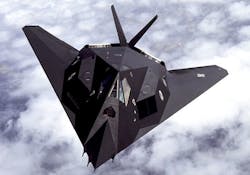THE MIL & AERO COMMENTARY, 5 July 2016. The U.S. military and its allies increasingly rely on so-called stealth technology to conceal their manned and unmanned aircraft from enemy radar. We forget, however, that radar is adapting quickly, and it's only one of many ways to detect aircraft.
Stealth aircraft technology has been one of the most expensive and closely guarded military secrets since reports of it first started appearing widely in the mid-1980s, with aircraft like the now-obsolete F-117.
Stealth uses angles and coatings to compromise the effects of enemy radar. It attempts to deflect and absorb radio waves to fool enemy radar into thinking an aircraft is something other than what it really is.
Let's be clear: stealth technology -- no matter how sophisticated -- doesn't make an aircraft invisible to radar. It simply enables an aircraft to hide radar clutter.
Today's radar systems are amazingly sensitive -- so sensitive, in fact, that one of the biggest radar signal-processing challenges today isn't detecting targets, but instead involves filtering out signals that are not of interest. Today's radar systems can detect and track targets as small as insects and birds, so an aircraft of any size, any shape, and any material isn't really a big problem.
Related: High-performance embedded computing could be crucial enabler of bistatic radar and sonar
Weather radar, for example, is designed to track wind currents and concentrations of rain, and increasingly is becoming effective in helping predict severe weather events like thunderstorms and tornadoes.
Rain isn't difficult for radar; it provides a nice return signal when its RF energy bounces off water droplets. Wind, however, is something different; there's nothing in moving air itself that can provide a radar return.
Instead, weather radar detects the stuff blowing around in the wind -- bugs, birds, leaves, and other solid objects that can reflect a radar signal. Ornithologists, in fact, are using the signals from weather radar to track the annual bird migrations.
If a radar can do this, rest assured it can detect even the smallest aircraft. The trick for radar designers is to know what they're looking for, and tune their radar systems and digital signal processing to detect and track the kinds of signals they want, and filter out the rest.
Related: New frontiers in passive radar and sonar
It follows, then, that stealth technology seeks to fool radar systems into filtering out their signals with the rest of the unwanted data. Once again, stealth aircraft aren't invisible to radar; they're just really sneaky about hiding in the radar clutter.
As radar systems become more sophisticated, as their digital signal processing algorithms become more advanced, and as signal-processing computers get faster, designing a stealth aircraft that can hide from radar will become really difficult and expensive to do.
We should think about this when we see reports, such as those appearing this week, about new stealth-detecting radar systems. Russia’s powerful over-the-horizon Podsolnukh (Sunflower) radar reportedly is capable of detecting and tracking stealthy fifth-generation aircraft like the Lockheed Martin F-35 or any other fighter jet designed to avoid detection.
If these reports are true, the Russian Sunflower radar isn't magic; it's just one step ahead in the cat-and-mouse game we call electronic warfare (EW). Aircraft designers will adjust, as will radar designers. There's really no end in sight, but I would guess that eventually no aircraft will be able to hide from radar.
Related: Stealth-detecting bistatic radar is back in the news
The problem gets worse if we stop fixating on radar as the only way to detect and track aircraft. There's more ways than radar to find a plane.
I live under the landing pattern of Manchester-Boston Regional Airport in Southern New Hampshire. I don't have any radar at my house, but I sure know when those Southwest 737 passenger jets are passing over. I can hear them, and I can see them -- whether I want to or not.
Think a sophisticated adversary trying to detect and track your stealth aircraft is using only radar? I doubt it. They're also listening and looking with sophisticated acoustic and electro-optical sensors. Against these kinds of measures a so-called stealth aircraft is helpless -- that is until he can fly silently and reflect no light whatsoever, and that's not happening any time soon.
Is there really such a thing as a stealth aircraft? That's getting harder and harder to accept.

